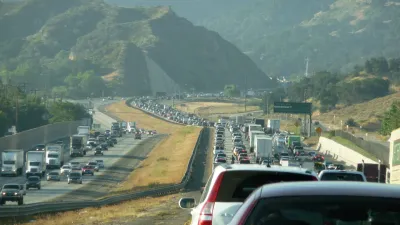Thirty years ago Peter Newman and Jeff Kenworthy introduced the concept of automobile dependency. In this article they reexamine the evidence, consider criticisms, and discuss how their insights changed—sometimes painfully—planning practices.

The abstract for "Gasoline Consumption and Cities Revisited: What Have We Learnt?":
This article provides a personal reflection 30 years after we created the concept of automobile dependence. The paper entitled “Gasoline Consumption and Cities: A Comparison of US Cities with a Global Survey and Its Implications” and an associated book “Cities and Automobile Dependence” stirred up transport planning, especially in the US. We examine the criticisms, [sic] this evoked at the time within the perspective of what has happened in cities since then. Key policy prescriptions of re-urbanizing cities and prioritizing transit, walking and cycling, [sic] have been largely mainstreamed, though not without some painful changes in professional practice such as road capacity increases being seen as the only solution to traffic. Urban planning and transport policies adopted in innumerable cities worldwide have moved to reduce automobile dependence, though academic and policy debate continues. The future is likely to continue this debate, especially over autonomous cars where there will remain a fundamental need to keep cities on a path of reduced automobile dependence by ensuring that hard-won principles of reurbanization of corridors, integrated with new transit alternatives and walkability at precincts/stations, are given the highest priority.
The entire study, published in Vol.9 No.3, September 2021 of the Current Urban Studies journal, is available with open access at the link below.
FULL STORY: Gasoline Consumption and Cities Revisited: What Have We Learnt?

National Parks Layoffs Will Cause Communities to Lose Billions
Thousands of essential park workers were laid off this week, just before the busy spring break season.

Retro-silient?: America’s First “Eco-burb,” The Woodlands Turns 50
A master-planned community north of Houston offers lessons on green infrastructure and resilient design, but falls short of its founder’s lofty affordability and walkability goals.

Delivering for America Plan Will Downgrade Mail Service in at Least 49.5 Percent of Zip Codes
Republican and Democrat lawmakers criticize the plan for its disproportionate negative impact on rural communities.

Test News Post 1
This is a summary

Test News Headline 46
Test for the image on the front page.

Balancing Bombs and Butterflies: How the National Guard Protects a Rare Species
The National Guard at Fort Indiantown Gap uses GIS technology and land management strategies to balance military training with conservation efforts, ensuring the survival of the rare eastern regal fritillary butterfly.
Urban Design for Planners 1: Software Tools
This six-course series explores essential urban design concepts using open source software and equips planners with the tools they need to participate fully in the urban design process.
Planning for Universal Design
Learn the tools for implementing Universal Design in planning regulations.
EMC Planning Group, Inc.
Planetizen
Planetizen
Mpact (formerly Rail~Volution)
Great Falls Development Authority, Inc.
HUDs Office of Policy Development and Research
NYU Wagner Graduate School of Public Service





























